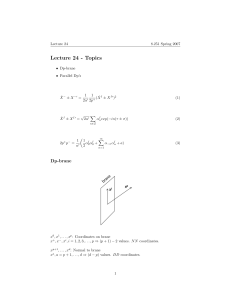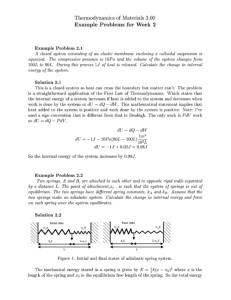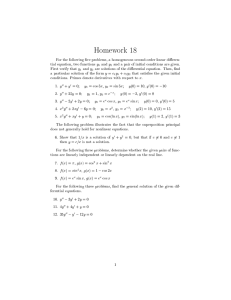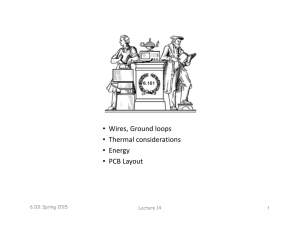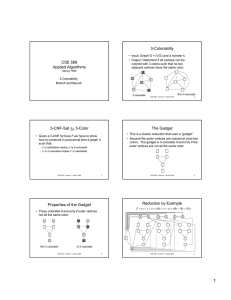Lecture 22 8.251 Spring 2007 ψ
advertisement
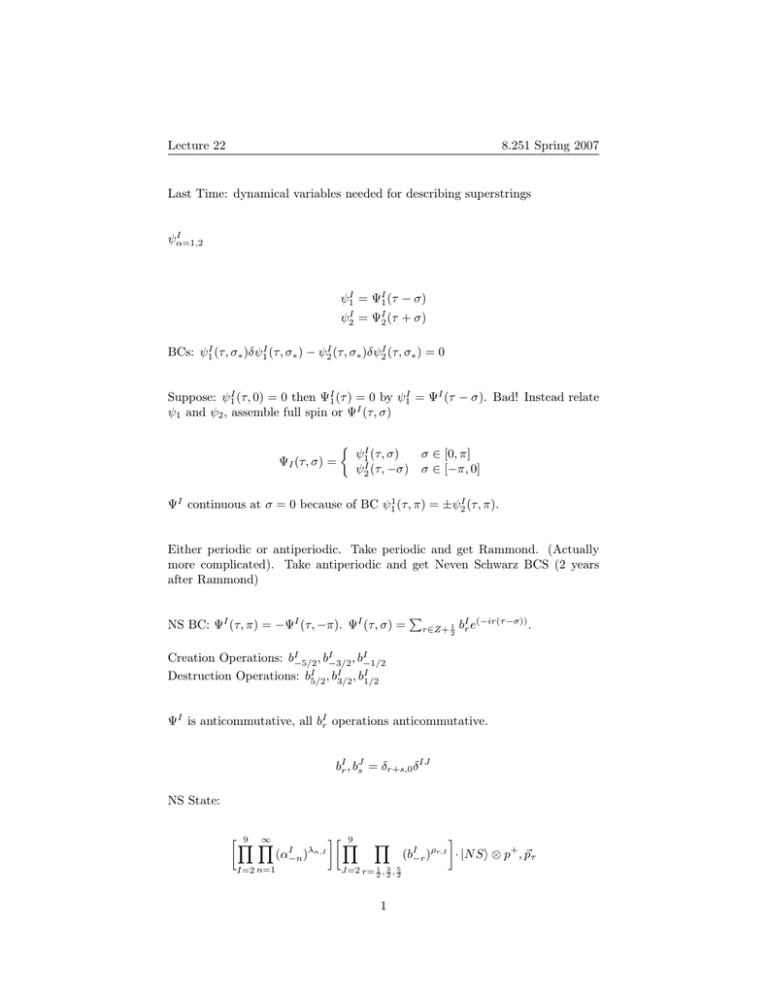
Lecture 22
8.251 Spring 2007
Last Time: dynamical variables needed for describing superstrings
I
ψα=1,2
ψ1I = ΨI1 (τ − σ)
ψ2I = ΨI2 (τ + σ)
BCs: ψ1I (τ, σ∗ )δψ1I (τ, σ∗ ) − ψ2I (τ, σ∗ )δψ2I (τ, σ∗ ) = 0
Suppose: ψ1I (τ, 0) = 0 then Ψ1I (τ ) = 0 by ψ1I = ΨI (τ − σ). Bad! Instead relate
ψ1 and ψ2 , assemble full spin or ΨI (τ, σ)
�
ΨI (τ, σ) =
ψ1I (τ, σ)
ψ2I (τ, −σ)
σ ∈ [0, π]
σ ∈ [−π, 0]
ΨI continuous at σ = 0 because of BC ψ11 (τ, π) = ±ψ2I (τ, π).
Either periodic or antiperiodic. Take periodic and get Rammond. (Actually
more complicated). Take antiperiodic and get Neven Schwarz BCS (2 years
after Rammond)
NS BC: ΨI (τ, π) = −ΨI (τ, −π). ΨI (τ, σ) =
�
r∈Z+ 12
bIr e(−ir(τ −σ)) .
Creation Operations: bI−5/2 , bI−3/2 , bI−1/2
Destruction Operations: bI5/2 , bI3/2 , bI1/2
ΨI is anticommutative, all bIr operations anticommutative.
bIr , bJs = δr+s,0 δ IJ
NS State:
��
9 �
∞
I
(α−n
)λn,I
n=1
I=2
�� �
9
J=2
�
r= 12 , 32 , 52
1
(bI−r )ρr,I
�
· |N S� ⊗ p+ , p�τ
Lecture 22
8.251 Spring 2007
ρr,I ∈ {0, 1}
Recall for open bosonic string, normal ordered:
M2 =
1
α�
� �
�
1
I
α−p
αpI
2
p∈Z
Now:
M2 =
1
2
�
1
α�
� �
�
1
1 �
I
α−p
αpI +
rbI−r bIr
2
2
1
rbI−r bIr = −
r=− 12 ,− 32
p∈Z
r∈Z+ 2
1 �
rbI bI
2 1 3 r −r
r= 2 , 2
=
1�
2
rbI−r bIr
r
1
= − (D − 2)
2
�
�
1 3 5
+ + + ...
2 2 2
�
��
�
1
12
1
1 1
= − (D − 2)
2 12
2
1
= − (D − 2)
48
1
For boson, aB = − 24
.
In open bosonic string, M 2 =
1
.
aB = − 24
1
α� (. . . + 1)
where a = −1 but 24 contributions so
1
Here, aN S = − 48
for antiperiodic fermion.
M2 =
∞
�
1 � I I
(
α−p αp +
rbI−r bIr + (D − 2)(aB + aN S ))
α p=1
1 3
r= 2 , 2
2
Lecture 22
8.251 Spring 2007
M2 =
1
1
(N ⊥ − )
α� tot 2
Add text here.
In early 1970s, confusion over whether these are bosons or fermions. It’ll turn
out that these are photons.
Count states of a given N ⊥
Given:
a+
1 : f (x) =
∞
�
n=0
xn
a(n)
����
number of states with N ⊥ =n
⊥
|0N ⊥ = 0, a+
= 1, (a1+ )2 |0N ⊥ = 2
1 |0N
f1 (x) = 1 + x + x2 + . . . =
1
1−x
Given:
2
4
a+
2 : f2 (x) = 1 + x + x + . . . =
1
1 − x2
⊥
2
⊥
|0N ⊥ = 0, a+
= 2, (a+
=4
2 |0N
2 ) |0N
f1 (x) = 1 + x + x2 + . . . =
Given:
+
a+
1 , a2 : f1 (x)f2 (x) =
1
1−x
1
1
·
1 − x 1 − x2
+ +
Now can do full open bosonic string with a+
1 , a2 , a3 , . . .
Generating Function:
fos =
∞
�
1
(1
−
xn )
n=1
3
Lecture 22
8.251 Spring 2007
fos =
∞
�
∞
�
1
=
(1 − xn ) n=0
n=1
p(n)
����
xn
partitions of n
Partitions of 4: ({4}, {3, 1}, {2, 2}, {2, 1, 1}, {1, 1, 1, 1}) = number of ways to get
N⊥ = 4
�
ln p(N ) ≈ 2π
N
6
1
√ exp(2π
p(N ) ≈
4N 3
�
N
)M
6
For full open string:
fos =
∞
�
1
(1
−
xn )24
n=1
This gives you degeneracy of any level of open string.
Given
Given
Given
Given
b+
1 : f1 (x) = 1 + x
2
b+
2 : f2 (x) = 1 + x
+ +
b1 , b2 : f12 (x) = √
f1 (x)f2 (x) = (1 + x)(1 + x2 )
+
b 1 : f 12 (x) = 1 + x
2
fN S (x) =
�
r
1
1
xr = 1− 2 + 8 · x0 + 36 · x 2 + (#)x1
a(r)
����
# of states with α� M 2 =r
�8
∞ �
1 � 1 + xn−1
=√
x n=1 1 − xn
Ramond: ΨI (τ, σ) =
�
I
dIn exp(−in(τ − σ)). dm
, dIn = δm+n,0 δ IJ .
dI0 → 8: 4 creation and 4 destruction = ξ1 , ξ2 , ξ3 , ξ4
4
Lecture 22
8.251 Spring 2007
Vacuum State: |0�
|0�: 1
ξ I ξ J |0�: 6
ξ1 ξ2 ξ3 ξ4 |0�: 1
This yields 8, |R1a �.
ξ I |0�: 4
ξ I ξ J ξ K |0�: 4
This yields 8, |R2a �.
� �
8 + 8 = 16 gound states. Total set of vacua states: �RA , A = 1 . . . 16, split into
2 types.
Ramond mass formula:
M2 =
∞
∞
1 � I I � I I
(
α
α
+
nd d )
α� p=1 −p p n=1 −n n
Substraction constant is equal to zero since aR =
α� M 2 = 0
α� M 2 = 1
|R1a �
I
α−1
|R1a �,dI−1 |R2a �
1
24
|R2a �
I
α−1
|R2a �,dI−1 |R1a �
Why is this supersymmetry? Left and right columns have opposite fermionic
states. Don’t know if R1a is a boston or a fermion, but know R2a is the opposite.
No bosons that look like |R1a � in real world
Partition function in Raman Sector
fR (x) = 16
�8
∞ �
�
1 + xn
n=1
5
1 − xn
Lecture 22
8.251 Spring 2007
To get supersymmtry, throw out half of the states from each sector and put
them together.
�∞�
1 �8
1 �8 �
∞ �
�
1 � 1 + xn− 2
1 − xn− 2
truncated
√
fN
=
−
S
1 − xn
2 x n=1 1 − xn
n=1
Anything with an odd number of fermions will change the sign.
?
fN S = 8
�8
∞ �
�
1 + xn
n=1
1 − xn
Do we or don’t we have supersymmetry?
1829: German Mathematician Jacoby wrote treatise on elliptic function with
this identity, labelled “a very strange identity”. Critical dimension D = 10 for
supersymmetry.
6
